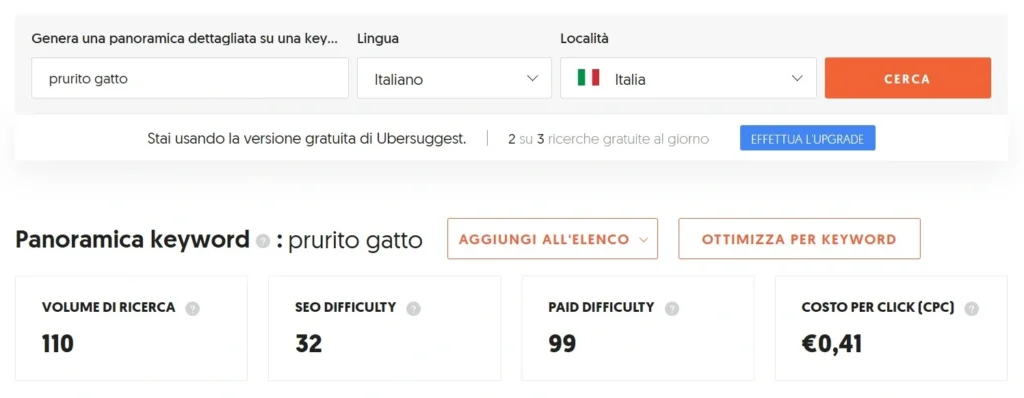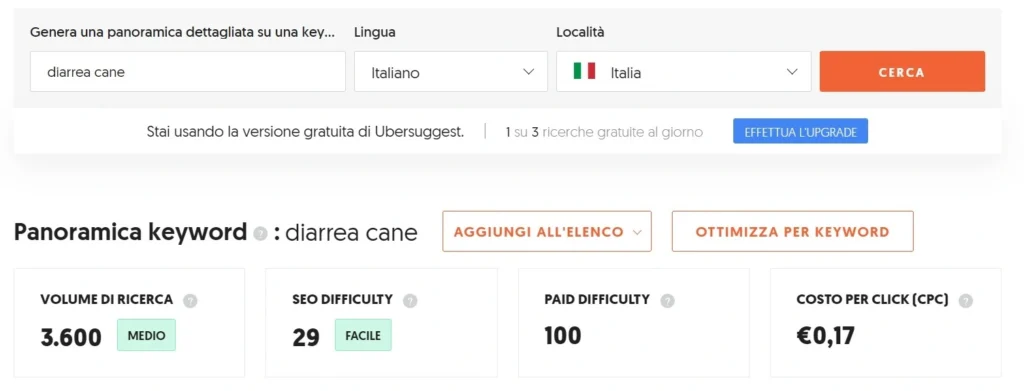
How to get more clients with SEO for veterinarians
What do you need SEO for if you are a veterinarian? Simple: attract traffic and turn it into paying customers! Learn how to optimize the structure and content of your website. … Read More

Sommario
Toggle[Important note: this article has been automatically translated from the original Italian language.]
Every day billions of people move online to seek information, services, solve a doubt or problem, among them are also the pet owners.
The majority of searches are really about information content: figuring out how to do something, learning more about a given topic, documenting.
In this article we will look at what a veterinary blog is And why it is so important to have one. We will talk about visibility e customer acquisition, in short, how to strategically manage the clinic blog, responding to the needs of users and keeping in mind the veterinarian’s economic goals.
The blog is a space on your website where you can publish text content, usually in the form of articles (or posts), which can also contain images, infographics and videos. The main characteristics of a blog are:
In short, the blog is the ideal tool for sharing your reflections and communicate your values, share information and create your own readership (create a community).
Imagine how many pet owners are looking for information about their pet’s management and health. Or how many times when faced with a symptom, they take action to understand the seriousness of the situation, or again with what interest they search for information online to decide who to entrust with the care of their dog or cat.
Whether you are a nutritionist, an orthopedic surgeon, or the medical director of a large clinic, you need to know that your clients have a million questions that they would like to have answered by an authoritative person: a veterinary physician. Think: How many questions do you get, even trivial ones, at first visits and checkups? What is trivial to you, is crucial to your clients-pet owners, how would you like it if instead of repeating the same information over and over again you put it in writing once and for all? So people could document themselves, especially because if you are not going to do it, someone else will do it for you….
How many times have you had clients come in already with a diagnosis ready because they read it on Google?
Instead of getting angry or stiffening in the face of such utterances, try offering them “your Google”!!!
Tap into the needs and curiosity of your patients by giving them correct, authoritative information that will increase your profits.
A veterinary blog can have different goals, the important thing is that the content published within it is consistent with the interests of its intended audience.
We need to distinguish the objectives of the communication made through the blog (what we want to talk about and why), from the business objectives (why start a blog? what kind of result do we want to achieve?).
The communication objectives can fall into two broad macro-areas:
The economic goals of blogging, on the other hand, have to do precisely with why you decide to use this communication tool:
Shorten the path of choice of customers (when in doubt about “who to turn to,” you want to be the preferred alternative).
Another thing you need to know before you start your blog is that nothing will be given away: there are no magic formulas for immediate results without commitment. All the results you get will come based on: quality of content, consistency in publication, consistencywith your marketing activities.
Let’s start with the cons:
Benefits of veterinary blogging:
Let’s look at the most interesting strategies to implement on your veterinary blog.
This strategy allows you to increase the visibility and traffic To your website. It is based on the study of the most frequent searches made by users online.
There are tools that allow you to get this information, here you see a screenshot of the famous Ubersuggest: a free tool that tells you the number of monthly searches performed by users for a given query (or keyword). In this case, I looked for “cat itch” and found that these words are searched 110 times a month in Italy:

Searching “dog diarrhea”, I find that it does 300% more searches!!!

So the strategy will be to create informative content useful in meeting the need of the person doing a particular search. Obviously, the content should be optimized according to the best practices of the SEO to be rewarded and appear in the top positions of the results offered by Google.

In this way, all searches for which you have published content will appear in Google’s SERP and bring visits to your website, without the need to pay for banners and advertisements. Not bad 😉
The Brand Awareness Is people’s awareness of the existence of your clinic or your name. The more “famous” your name is, the more you will be “considered” among the options of choice at the time of need.
So be careful to Cover the topics for which you would like to be recognized as an “extremely authoritative veterinarian”. For example, if you are involved in eye disease and microsurgery of the eye, focus on these issues.
One strategy that can be implemented through the blog to improve the spread of your name is what we saw in the previous point (visibility and SEO): but it is not the only way to bring people to know of your existence.
La sharing on social is critical, then:
Engagement can be achieved through news and info-graphics contained in blog articles. Le infographics are images that schematize a concept, a process, a guide to solving a problem.
Example:
The blog is a very useful tool for collecting contacts of people interested in your service or a particular issue.
This activity is very important because it allows you to create a database of profiled contacts that you can use for your email marketing campaignsor sms marketing.
By profiled contacts we mean a contact about whom we know more than just his first and last name: we may know if he is an animal owner (and what animal: dog, cat, breed, etc.) or a veterinarian (maybe he is a professional who follows our publications), where he lives (same city or on the other side of Italy?), whether he is already a client or not, etc.
All this information is useful for managing communication campaigns (we talked about this in connection with the Business Intelligence).
The most effective strategies for doing lead generation from the blog are:
I hope you are now more clear about the strategic management of the veterinary blog: a tool at the service of your clinic to improve communication, intercept new patients and increase your turnover.
The important thing, before you start, is to be clear about your goals and the strategy to be implemented.
Good work!
Related articles

What do you need SEO for if you are a veterinarian? Simple: attract traffic and turn it into paying customers! Learn how to optimize the structure and content of your website. … Read More

How long does it take you to arrange a surgery? How long does it take your staff to make a visit? How many drugs do you let expire?
If you can’t answer these questions, you are missing an important growth opportunity for your veterinary facility because you are not understanding where you can improve. … Read More

You dream of having a well-organized structure in the diary, with no appointment cancellations with a purchase schedule (for better management of discounting as well).
You would love to have owners who trust and are not distracted by competitors because you are able to keep them attached to you because of your authority, humanity, and ability to be unique.
How can such a desire be realized? Organizing Prevention Plans or Health Plans, customized for each of your clients, who will feel unique, special and pampered just by you.
Find out how to structure them here.
… Read More

We are redirecting you to the cart to finalize the requested subscription change.
Lorem ipsum dolor sit amet, consectetur adipiscing elit. Ut elit tellus, luctus nec ullamcorper mattis, pulvinar dapibus leo. Lorem ipsum dolor sit amet, consectetur adipiscing elit. Ut elit tellus, luctus nec ullamcorper mattis, pulvinar dapibus leo.